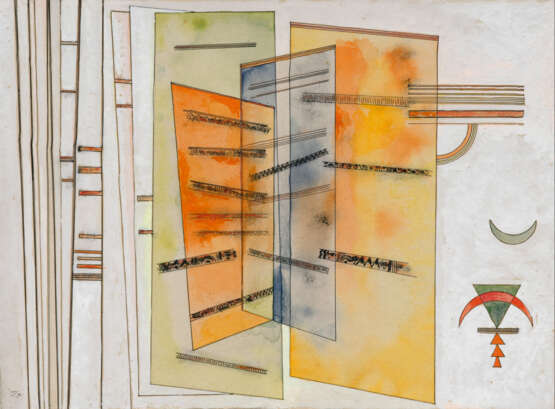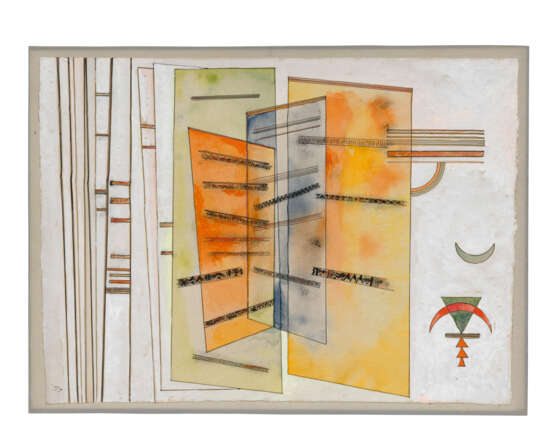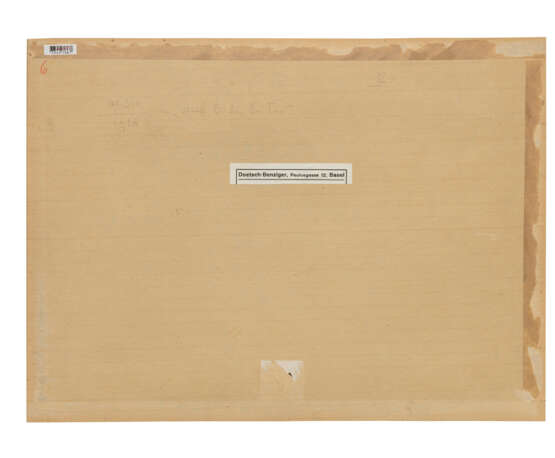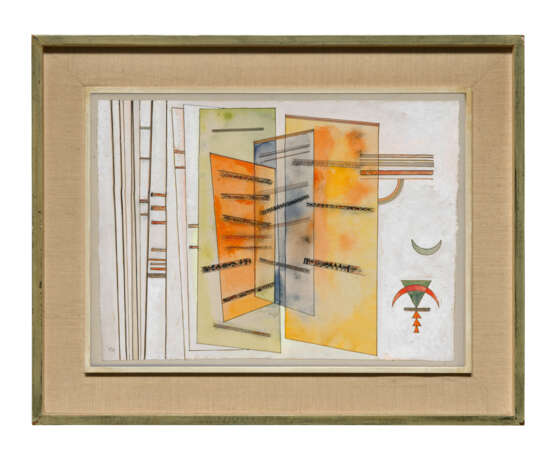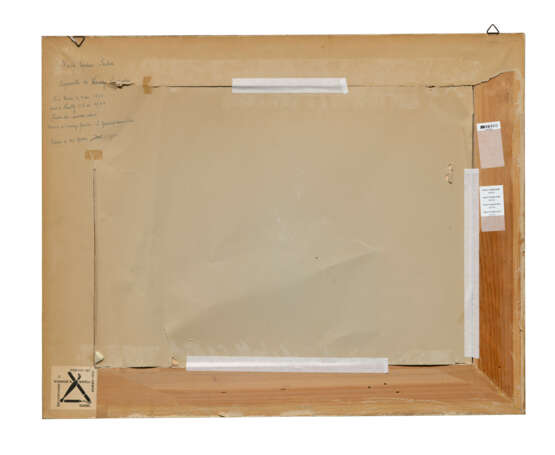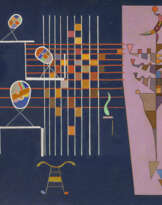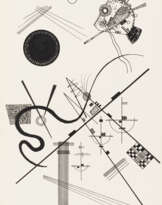ID 1307036
Лот 103 | Vassily Kandinsky (1866-1944)
Оценочная стоимость
€ 200 000 – 300 000
Nach Beiden Seiten
monogrammé et daté '28' (en bas à gauche)
gouache, aquarelle et encre de Chine sur papier
35.5 x 48.5 cm.
Exécuté en octobre 1928
signed with the monogram and dated '28' (lower left)
gouache, watercolour and India ink on paper
14 x 19 1/8 in.
Executed in October 1928
Provenance
Kandinsky Gesellschaft.
Richard Doetsch-Benziger, Bâle (acquis auprès de celle-ci en 1928 et jusqu'à au moins 1945).
Galerie d'Art Moderne, Bâle.
Collection Roesler, Bâle (acquis auprès de celle-ci en 1953).
Puis par descendance au propriétaire actuel.
Literature
Liste de l'artiste, Aquarelle, 'x 1928, 310, Nach beiden Seiten'.
V. Endicott Barnett, Kandinsky, Aquarelles, Catalogue Raisonné, 1922-1944, Londres, 1994, vol. II, p. 234, no. 900 (dessin de l’artiste executé d’après la présente œuvre).
Exhibited
Paris, Galerie Zak, Exposition d'aquarelles de Wassily Kandinsky, janvier 1929, no. 53.
Bâle, Kunsthalle, Gedächtnis-Ausstellung Wassily Kandinsky, mars-avril 1945, p. 7, no. 6.
Further details
Kandinsky peint Nach Beiden Seiten (Vers les deux côtés) en 1928, année pendant laquelle il obtient la nationalité allemande et se voit confier par Georg Hartmann, directeur artistique du Friedrich-Theatre de Dessau, un grand projet de mise en scène théâtrale et musicale. Kandinsky choisit d’illustrer la composition au piano Bilder einer Ausstellung (Tableaux d'une exposition) conçue par Modest Mussorgsky en 1874. Ce projet influence fortement le reste de ses compositions, à l’instar de Nach Beiden Seiten qui semble avoir été inspiré par les formes du décor de la scène. A travers l’aquarelle, Kandinsky explore les idées de transparence en superposant certaines formes et certaines éléments. Il joue avec leurs couleurs internes pour créer un sentiment complexe de superposition et de profondeur de la scène.
L’année 1928 marque également la résignation de Walter Gropius de l’Ecole du Bahaus. Fondée en 1919 à Weimar par ce dernier, l’école est devenue en quelques années seulement un haut lieu d’éducation artistique et théorique. Initialement tournée autour de l’exploration de l’expressionnisme allemand et du style constructiviste, l’école acquiert une dimension internationale grâce à son curriculum singulier plaçant sur un pied d’égalité les enseignements de design, d’architecture, de peinture et d’ingénierie. Cette atmosphère stimulante dans laquelle évolue les élèves et leurs maîtres permet à Kandinsky, enseignant au Bahaus de Dessau depuis 1922 et directeur du cours libre de peinture, d’explorer de nouveaux thèmes et de pousser ses théories artistiques à un niveau supérieur. En 1928, lui et Paul Klee se voient confier davantage de classes suite à la nomination de Hannes Meyer, célèbre architecte suisse, à la tête de l’école. Kandinsky publie alors un nouvel article théorique intitulé ‘Art Pedagogy / Analytical Drawing’ et s’adresse à ses élèves de la manière suivante : « L'enseignement du dessin au Bauhaus est une éducation au regard, à l'observation précise et à la représentation précise non pas de l'apparence extérieure d'un objet, mais des éléments constructifs et de leur construction logique. » (C. V. Poling, Kandinsky’s Teaching at the Bahaus, Color Theory and Analytical Drawing, 1986).
Nach Beiden Seiten, qui suit en tous points les principes de simplification de la forme, d’analyse des compositions structurelles et de transformation de la composition enseignés par Kandinsky, entre en 1928 dans la collection de Richard Doetsch-Benzigern, un industriel pharmaceutique établi à Bâle. Important collectionneur de livres, de peintures d’artistes allemands du Bahaus tels qu'Otto Freundlich, Paul Klee ainsi que de leurs camarades français tels que Henri Rousseau , Marc Chagall , Joan Miró , Henri Matisse , Pablo Picasso et Henri Laurens ; Doetsch est l’un des principaux donateurs du Kunstmuseum de Bâle et fonde la première Société Paul Klee.
L’année suivante, en février 1929 plus précisément, la Galerie Zak organise la toute première exposition personnelle dédiée aux dessins et aquarelles de Kandinsky. Nach Beiden Seiten, exécuté pendant les années les plus créatives et les plus réussies de Kandinsky à Dessau, y est exposée. Eleftheriadis Tériade, critique d’art français et éditeur, écrit la préface de l’exposition et proclame : « Kandinsky est un peintre doublé d’un savant. L’œuvre qu’il a entreprise, avec une foi magnifique, aussi éloignée qu’elle puisse paraître d’un idéal latin mérite le respect et même l’admiration. (…) Kandinsky nous montre déjà aujourd’hui des réalisations émouvantes par leurs qualités picturales et par leur authenticité. Du symbolisme oriental de la Russie et de l’esprit musical de l’Allemagne naîtra peut-être un art pictural qui permettra à l’expression profonde de l’homme d’atteindre une pureté intense et inespérée ». (E. Tériade, Exposition d'aquarelles de Wassilly Kandinsky, cat. ex., Galerie Zak, 1929).
Kandinsky painted Nach Beiden Seiten (To Both Sides) in 1928, the year in which he obtained German nationality and was entrusted by Georg Hartmann, the artistic director of the Friedrich-Theatre in Dessau, with a major theatrical and musical staging project. Kandinsky chose to illustrate the piano composition Bilder einer Ausstellung (Pictures at an Exhibition) conceived by Modest Mussorgsky in 1874. This project had a strong influence on the rest of his compositions, such as Nach Beiden Seiten, which seems to have been inspired by the shapes of the stage set. Using watercolours, Kandinsky explored the effects of transparency by superimposing certain shapes and elements. He played with their internal colours to create a complex sense of superimposition and depth in the scene.
The year 1928 also marked Walter Gropius's resignation from the Bauhaus School. Founded by Gropius in Weimar in 1919, the school had become a major centre of artistic and theoretical education in just a few years. Initially focused on exploring German Expressionism and the Constructivist style, the school acquired an international dimension thanks to its unique curriculum, which placed design, architecture, painting and engineering on an equal footing. This stimulating atmosphere for students and teachers enabled Kandinsky, who had been teaching at the Bauhaus in Dessau since 1922 and was head of the free painting course, to explore new themes and push his artistic theories to the next level. In 1928, he and Paul Klee were given more classes following the appointment of Hannes Meyer, the famous Swiss architect, as head of the school. Kandinsky published a new theoretical article entitled ‘Art Pedagogy / Analytical Drawing’ and addressed his students as follows: ‘The teaching of drawing at the Bauhaus is an education for the eye, in terms of precise observation and precise representation not of the external appearance of an object, but of its constructive elements and their logical construction.’ (C. V. Poling, Kandinsky's Teaching at the Bauhaus, Color Theory and Analytical Drawing, 1986).
Nach Beiden Seiten, which follows in every respect the principles of simplification of form, analysis of structural compositions and transformation of composition taught by Kandinsky, entered the collection of Richard Doetsch-Benzigern, a pharmaceutical industrialist based in Basel, in 1928. An important collector of books and paintings by German Bauhaus artists such as Otto Freundlich and Paul Klee, as well as their fellow French counterparts Henri Rousseau, Marc Chagall, Joan Miró, Henri Matisse, Pablo Picasso and Henri Laurens, Doetsch was one of the main donors to the Basel Kunstmuseum and founded the first Paul Klee Society.
The following year - in February 1929 - the Galerie Zak organised the very first solo exhibition of Kandinsky's drawings and watercolours. Nach Beiden Seiten, executed during Kandinsky's most creative and successful years in Dessau, was exhibited there. Eleftheriadis Tériade, the French art critic and publisher, wrote the preface to the exhibition and proclaimed: ‘Kandinsky is a painter as well as a scholar. The work he has undertaken, with magnificent faith, however far it may seem from a Latin ideal, deserves respect and even admiration. (...) Kandinsky is already showing us works that are moving in their pictorial quality and authenticity. From the oriental symbolism of Russia and the musical spirit of Germany will perhaps emerge a pictorial art that will allow the profound expression of man to reach an intense and unhoped-for purity’. (E. Tériade, Exposition d'aquarelles de Wassilly Kandinsky, cat. ex., Galerie Zak, 1929).
| Автор: | Василий Васильевич Кандинский (1866 - 1944) |
|---|---|
| Техника исполнения: | Гуашь |
| Художественный стиль: | Модернизм |
| Место происхождения: | Восточная Европа, Европа, Россия |
| Категория аукционного дома: | Картины, Акварели, Рисунки, Акварели и рисунки |
| Автор: | Василий Васильевич Кандинский (1866 - 1944) |
|---|---|
| Техника исполнения: | Гуашь |
| Художественный стиль: | Модернизм |
| Место происхождения: | Восточная Европа, Европа, Россия |
| Категория аукционного дома: | Картины, Акварели, Рисунки, Акварели и рисунки |
| Адрес торгов |
CHRISTIE'S 9 Avenue Matignon 75008 Paris Франция | ||||||||||||||
|---|---|---|---|---|---|---|---|---|---|---|---|---|---|---|---|
| Предосмотр |
| ||||||||||||||
| Телефон | +33 (0)1 40 76 85 85 | ||||||||||||||
| Факс | +33 (0)1 40 76 85 86 | ||||||||||||||
| Условия использования | Условия использования | ||||||||||||||
| Транспортировка |
Почтовая служба Курьерская служба Самовывоз | ||||||||||||||
| Способы оплаты |
Банковский перевод | ||||||||||||||
| Часы работы | Часы работы
|
